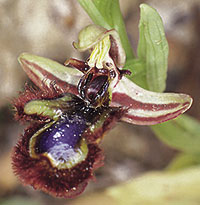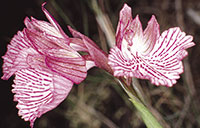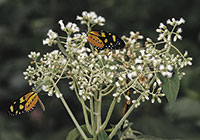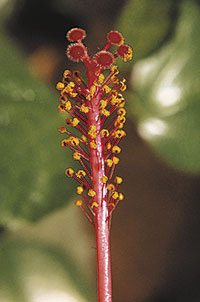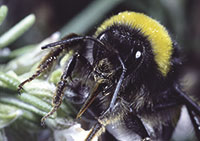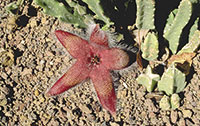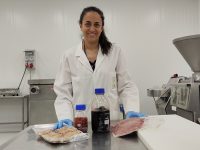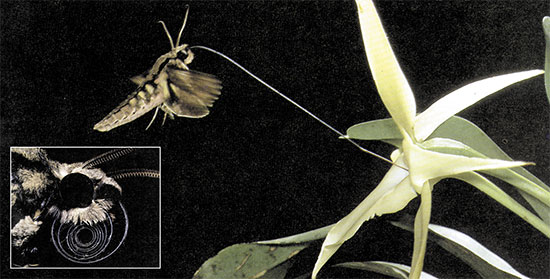
|
Plant sexuality. Plant sexuality is much more complex than we could have imagined. The absence of movement prevents individuals of either sex from coming together so their gametes can fuse. Therefore plants have had to resort to different mechanisms, which are sometimes very sophisticated, to succeed in bringing the male and female gametes together, as well as to avoid inbreeding or self-fetilisation. Plants did not have sex or sexuality, at least for botanists, until the late seventeenth century. Curiously, man knew since ancient times that harvests improved if their meeting was favoured with the proper management of male and female reproductive structures. Thus, ancient Egyptians cultivated female date palms – those that produced dates –, which were opportunely pollinated, for which purpose the male inflorescences were cut and smeared over the female flowers. At the same era, people in Greece and Turkey performed another process to approach the sexes productively, in this case on the fig tree, called caprification: they strung up some caprifigs – wild figs with male flowers – and hung them on the branches of the domestic fig trees, which only bear female flowers. Surely farmers did not need to reflect on the reasons for the effectiveness of their practice, they knew that approaching two different organs of the same plant increased fruit production. Meanwhile the brainy scientist, always in need to tie everything together, and often having preconceptions of all kinds, some his own, others of his time, was reluctant to find the most logical explanation for that which nature showed him so easily. It is true that throughout the history of botany we can often see references to male and female plants, but they are all linked to the properties of their outer appearance: beauty, vigour, size, resistance, colour, scent, etc. This distinction had nothing to do either with the reproductive organs or with the recognition of the existence of sexes in the plant kingdom, but rather with what they considered to be characteristics of masculinity or femininity. These references to opposite sexes were often applied to individuals of different species and even different genera, which were therefore unable to interbreed. This is the case of the male fern – Dryopteris filix-mas (L.) Schott – and the lady fern – Athyrium filix-femina (L.) Roth-; and also of the old man wormwood – Atermisia abrotanum L. – and the cotton lavender – Santolina chamaecyparissus. Sexuality was seen as a purely animal action, which responded to an appetite, a call between the sexes, which is why it could only occur between organisms with sensitivity, and it required procreation and sexual organs; all of which man, the observer, had, but which plants lacked, so they also lacked sexuality. For centuries botanists held this interpretation that stemmed from the acceptance of the ideas of natural philosophy and Galenism; only observation, as in many other cases, disabused them of that belief. In the second half of the seventeenth century the widespread use of microscopes and their application to the study of plant structures enabled Marcello Malpighi and Nehemiah Grew to publish two individual treaties on plant anatomy in which they thoroughly described all plant organs, including reproductive organs. Rudolf Jacob Camerarius performed tests with plants in his garden, such as the castor oil plant (Ricinus communis L.), the common hop (Humulus lupulus L.) or the annual mercury (Mercurialis annua L.): he removed the male flowers before pollen was released, isolated female flowers and performed hand pollinations. He concluded that no fruit was produced if pollen was not involved: he is credited with the discovery of plant sexuality. He published his results in 1694, but for more than three decades his conclusions were heatedly criticized by botanists, who could not accept such proximity between animals and plants. Linnaeus was an advocate of the sexual function of stamens and pistils. He argued his defence forcefully and, as it is known, based his classification system for plants on their sexuality, not without a great inner effort that he wrote down around 1730: «I left aside preconceived ideas, I became skeptical and questioned everything; only then were my eyes opened; only then I saw the truth». Yet five years went by before he published his proposal to order plants in 24 classes, 23 dedicated to plants with «public marriages», those known as phanerogams, each characterised by a particular combination of the floral pieces, and the last category, for all plants with «clandestine marriages», cryptogams, whose lack of flowers leave their reproductive structures hidden to the eyes of the observer. AVOIDING INBREEDING Over three hundred years have passed since Camerarius published his work and during this time we have deepened our knowledge on the reproductive systems of plants and we have been able to realise how complex they are. It is known that inbreeding produces within a few generations an impoverishment of the genetic diversity of the population, an accumulation of defects and the homozygosity of genes, which limits the responsiveness of individuals to changes in the environment. Therefore, it is not desirable for any living organism and all of them have tried to avoid it by developing more or less complex reproductive mechanisms. One of the most effective actions to avoid inbreeding was the separation of sexes in different individuals. This strategy is effective for animals, which, in general, are able to move and base their sexual relations in the movement of individuals. Males and females seek and find each other before their reproductive cells, the gametes, fuse. In the late nineteenth century naturalist Alfred Russel Wallace made one of the first predictions based on the theory of co-evolution of insects and plants. In Madagascar he observed an orchid (Angraecum sesquipedale Thou.) that had a very long nectar spur. He postulated that its pollinator, which nobody knew, must have been a moth with a proboscis of at least 25 cm. Decades later a new subspecies of Xanthopus morgani, Sphingidae found in the Indo-Australian area, was discovered, that had indeed the expected proboscis. This very close tie between plants and insects is relatively common but can be fatal for both, since the disappearance of either can sentence the other to starvation or sterility. Plants, in turn, are autotrophic organisms that obtain energy from sunlight, so they do not need to move around to get food and therefore lost their mobility more than 500 million years ago. For a long time, plants retained sexual reproduction linked to the aquatic environment, where they released flagellated gametes that swam to their meeting. This is still preserved in algae, mosses and lichens, but when plants conquered the land surface and separated from water definitively, in the reproductive stage they had to transform their reproductive organs, among others. Gametes could no longer be released freely in an increasingly dry environment, but had to be housed in protective structures: one fixed, the ovule, and other mobile, the pollen. Once the protection of the gametes was resolved, plants also attempted the separation of sexes in different individuals and, in an Earth without animals, they could only trust the union of sexes to the wind. The pollen floated in the air looking for a primordium that was rarely found. The strategy of dioecy, the separation of sexes into different individuals, must not have been successful since plants grouped male and female reproductive structures little by little. Initially in the same individual, that is how they are found in most gymnosperms, and then in the same flower, in up to 80% of angiosperms, while only 4% of them are dioecious. The typical flower is a reproductive structure containing many organs in a small space, including those that produce male and female gametes. The result is that pollen is located a few millimetres away from the ovule. Why, then, after all this effort to unite the two sexes, do plants not leave pollination to gravity? For the same reason animals separated the sexes into different individuals: to avoid inbreeding. To avoid auto-fertilisation, which would have compromised the genetic turnover of the species, plants have developed different strategies. Some try to avoid self-pollination by developing spatial barriers – herkogamy – between male and female organs so that their own pollen cannot reach the stigma; such is the case of flax (Linum sp.) or primroses (Primula sp.), but perhaps it is easier to observe this phenomenon in the arrangement of pine cones, with the female on top and the male below, relying on gravity so that the pollen of a plant does not reach its own primordia. Other strategies involve the development of temporal barriers – dichogamy – so that the mismatched maturation of anthers and stigma prevents inbreeding. In some cases the stamens mature earlier, as in most Umbelliferae and Compositae, while in others the stigma is receptive before the pollen matures, perhaps the simplest example is that of the flower of the magnolia (Magnolia grandiflora L.). But often plants also use other biochemical mechanisms that prevent self-fertilisation in case of self-pollination: these are the systems of incompatibility. They work because of the flower’s ability to recognise its own pollen in the stigma. In case of recognition, if the plant is self-incompatible, the pollen grain fails to germinate or, if it does, the pollen tube does not reach the ovule, preventing self-fertilisation. Obviously this mechanism is characteristic of flowering plants (angiosperms) that have carpels with a stigma at the end; gymnosperms do not have any incompatibility because their primordia are naked. In 1977 Cruden published the results of his extensive study on the relation between the pollen and the ovules of angiosperms. He found that strict xenogamy requires plants to produce around 500,000 pollen grains for each ovule developed. This number is one thousand times higher than the production per ovule of plants with strict self-fertilisation. Obviously the huge expense of energy that this huge production of pollen requires must be balanced by the genetic diversity provided by cross-fertilisation. POLLINATION SYSTEMS The first gymnosperms appeared on Earth before insects, there were virtually no land animals and they could only rely on wind to transport pollen. All gymnosperms are anemophilous, like the most primitive angiosperms. Wind is actually an agent that carries pollen, but transport is random. The consequence is that to ensure successful pollination, wind-pollinated plants have to produce large quantities of pollen; it is estimated that a single birch produces several billion pollen grains that will give rise to only a few hundred seeds. Anemophilous plants organise their male flowers to maximise the incidence of wind on pollen and pollen is even modified to linger in the air for longer. Spheroidal pollen grains or pollen grains with bladders predominate. The receiving part of the female flower is also transformed to offer maximum catchment area, as a radar antenna or as an antenna that extends into the air to catch the pollen grains. Wind-pollinated plants do not develop eye-catching flowers, but they invest much energy, probably more than that invested by eye-catching flowers, as pollen is formed mainly by proteins, complex organic molecules whose production is a major cost. Furthermore, such investment is often wasteful, most times the grain of pollen does not reach the stigma of an appropriate flower. Looking for saving and efficiency, plants had to change their strategy and found in insects the perfect instrument, so they became entomophilous. Flowering plants appeared on Earth when insects already flew, some 250 million years ago; they have co-evolved with them, as they are their main pollinators. It is true that certain mammals (bats, shrews, mice) act as carriers of pollen from some specific families like Proteaceae and Myrtaceae. It is also true that hummingbirds have established pollination relationships with tropical plants. But these cases do not cease to be unusual because insects are the most common pollinators. The flower offers a reward and the insect transports it «from door to door». It is true that this required an important modification of both the external parts of the flower (calyx and corolla), which served as a lure and guide for pollinators, and of the internal parts (stamens and pistils), which had to adopt a proper position to exchange and receive pollen. In addition, the plant had to offer the insect a bait that sometimes is a real reward for the work done, while others is just a trick. Species that produce pollen or nectar remunerate work with a product which is very rich in energy, on which the insect feeds by going from flower to flower, day after day. At each visit it takes an amount of pollen that it transports to another flower. But there are truly wicked species that imitate shapes, colours or scents to really trick the insect. Insects seek in them something they do not find, but they end up coated with pollen that they will transport to the next flower-deception; the plant gives them absolutely nothing in return, only disappointment, if insects can feel it. Some orchids are among the most reputable imitators, some disguise themselves as female insects, the male flies over and dashes to it attempting copulation, which cannot be consummated, and finally leaves in search of another opportunity that often occurs as another imitating flower, where the scene will be repeated. At other times the flower is like a male that, on being seen within its territory, is attacked violently by the real male; the outcome of the fight is none other than a fooled insect that resumes its flight taking with it the pollen that will be carried to another false enemy. But sometimes shapes alone are not effective; it is sometimes necessary to combine them with colours and smells. Some Asclepiadaceae in Southern Africa deserts produce large flowers, with a fleshy surface lightly covered with hair, of a suspiciously peachy colour and whose centre emits a foul odour of rotting flesh. This combination of characteristics is enough to attract flies that feed on decaying flesh, which do not find what they want but act instead as pollen transporters. The sophistication of plants reaches extreme lengths in their quest for pollinators. Aroids are not only able to imitate the appearance of rotting flesh, including the smell, but are also able to generate heat within the inflorescence to trick the insect into believing that it is entering a rotting corpse; once inside, it will only find male and female flowers which it will help to pollinate without further reward than deception. Some terrestrial plants returned to the aquatic environment millions of years after having abandoned it as a result of a process of reconquest that has been present in various groups of angiosperms. However, they have retained the sexual reproduction systems developed by their ancestors. They are plants with anthers that release pollen and with stigmas that receive it. They were just forced to adapt their pollination mechanisms to an unfavourable environment; we should not forget that pollination appeared in response to the adaptation of plant life on land. The pollen of aquatic plants is not dispersed, unlike that of the anemophilous plants; it is instead aggregated forming floating clouds that reach the stigmas, both in the inflorescences located on the surface as in those submerged. There is a singular case of pollination of aquatic plants that somehow recalls the encounter between animals of opposite sex. It occurs in the genus Vallisneria. Submerged male flowers are released before the opening of the anthers and rise to the surface. Once up, the flowers float and are propelled by the wind to which the petals and stamens are exposed. The female flowers remain joined to the plant, at the ground level, where they form a small depression in the water. When the male flower falls into the depression the anthers transfer the pollen to the stigma and pollination occurs. Finally there are cases of genuine strict and forced self-pollination and self-fertilisation; it occurs in cleistogamous flowers, which fail to open once formed but which are capable of producing fertile fruit. This strategy is present in some colonising plants or plants typical of deserts, where the chances of finding pollen from another individual are remote, due to the absence of pollinators or the lack of other individuals of the same species. Jaime Güemes. Botanical Garden of the University of Valencia. |
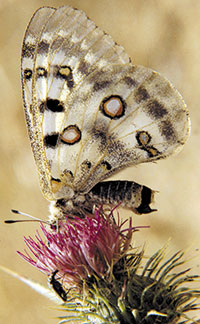
Parnassius apollo, photographed in the natural park of Penyagolosa. Butterflies are big consumers of nectar but their contribution to pollination is limited. With long proboscides that reach the nectar at the bottom of florets without being coated with pollen, their slender bodies hardly ever graze the anthers and only a few grains of pollen stick to their legs. Photo: J. Pellicer
The size of the flowers has been declining throughout the evolutionary process of plants, but small flowers are unattractive and at risk to go unnoticed by pollinators. To avoid this, small flowers have grouped into inflorescences that act as a striking lure that attracts insects, but each flower is then later pollinated and develops fruit independently. Closeup of hibiscus flower (Hibiscus sp.) from the mallow family. Plants try to avoid self-pollination by developing spatial barriers – herkogamy – between male and female organs.
Geometridae caterpillar on Santolina chamaecyparissus L. The flower-eating caterpillars act as specialised pollinators. Like any insect that walks on the flowers of a plant, it is coated with pollen that is transferred to other flowers when moving around. In this case the plant has not developed specific reward structures and pollination supposes significant energy expenditure, as the caterpillar carries pollen but eats a large part of the pollinated flowers before they turn into fruit. Cistus laurifolius L. All rockroses are cross-pollinated plants, they require the participation of pollinators to develop fruits and seeds. Their flowers do not produce nectar but they do produce large amounts of pollen that attract many insects, mainly beetles, honeybees and bumblebees that, besides feeding on pollen, are coated with it and carry it to their next visit. Stapelia hirsuta L. Some plants have developed mimetic flowers with features reminiscent of rotting flesh, they can even copy its bad smell and warmness. They lure flies that, despite not being able to enjoy the expected feast, leave with a load of pollen that they carry to another flower.
|

